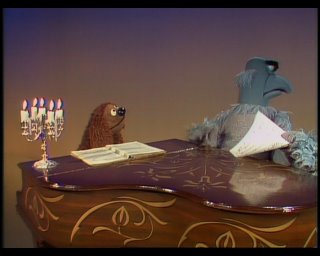Tit Willow
 "So we fix our eyes not on what is seen, but on what is unseen. For what is seen is temporary, but what is unseen is eternal." 2 Corinthians 4:18
"So we fix our eyes not on what is seen, but on what is unseen. For what is seen is temporary, but what is unseen is eternal." 2 Corinthians 4:18
Great words there, but what does it have to do with puppets you might ask. Well, if you're involved in any sort of ministry, whether it's puppetry or underwater basket weaving, hopefully you understand the true meaning of this passage. But I highlight it here because I want to talk about the "unseen" in our puppet performances.
There are many aspects of a puppet performance which are unseen to the audience. For example, the puppet's legs. If we're really trying to achieve the illusion of life with our puppets, then we should try to make our puppets look as if they have real legs they are walking around on, even though we don't see them. Remembering that there is an unseen elements to our puppet programs can help create a bigger and more real world for our puppets to inhabit. A great example of this is Rowlf the Dog and Sam the Eagle's performance of Gilbert & Sullivan's "Tit Willow" from Season 1 of The Muppet Show.
I love Sam the Eagle, a key element of his character is that he just plain doesn't want to be there. You have to wonder why on earth he even hangs around with the Muppets at times. In "Tit Willow" Rowlf has given Sam the job of playing the part of the bird, which means that all he has to do his recite the line "Willow, Tit Willow, Tit Willow" at the appropriate times. As the song moves on Rowlf remains as enthusiastic as ever, while Sam becomes less and less thrilled with his role.
 As Sam grows more self conscious about this whole thing, he looks over his shoulder several times. You can also see him make gestures and mumble things as if he is talking to someone standing offstage. We don't see who he's talking to, but it's clear that someone is there. I picture Fozzie, Gonzo and the other Muppets doing a lousy job of holding back laughter and making sure that Sam can see them.
As Sam grows more self conscious about this whole thing, he looks over his shoulder several times. You can also see him make gestures and mumble things as if he is talking to someone standing offstage. We don't see who he's talking to, but it's clear that someone is there. I picture Fozzie, Gonzo and the other Muppets doing a lousy job of holding back laughter and making sure that Sam can see them.
 At one point, Same even says to whoever is watching him, "You wanna do this?" To me these little touches just help to make the audience forget that they are watching puppets. These are real characters. They live in a real world and they have real emotions. These are the things that are unseen to us in the audience, but when the puppets direct our attention that way it helps to create that "illusion of life."
At one point, Same even says to whoever is watching him, "You wanna do this?" To me these little touches just help to make the audience forget that they are watching puppets. These are real characters. They live in a real world and they have real emotions. These are the things that are unseen to us in the audience, but when the puppets direct our attention that way it helps to create that "illusion of life."






2 comments:
As you've observed, there is no better visual textbook of puppetering than the work of Frank Oz.
The Tit Willow song is a terrific example. Oz's imagination is so detailed regarding motivation and psychological history of the character, not to mention (as depicted here) what might be going on off-stage, just out of camera range.
Lots to learn in these clips you mention.
GREAT BLOG!
Steve P
www.petrapuppets.com
Post a Comment